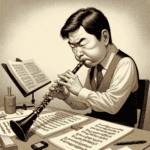Introduction to Clarinet Embouchure
The clarinet embouchure is a delicate mix of precision, strength, and adaptability. Whether you're new to the instrument or a seasoned player, honing your embouchure and building strong muscle memory can feel like a lifelong journey. The minute adjustments made in the lips, jaw, and facial muscles translate directly into the quality of sound. So, how do you get your embouchure into tip-top shape while ensuring reliable muscle memory? Let's explore this key aspect of clarinet playing.
What is Embouchure?
First off, let's break down the embouchure. Think of it as the position and control of your mouth when engaging the clarinet's mouthpiece and reed. It's a tiny setup but makes a monumental difference. A solid clarinet embouchure supports the reed's vibration, allowing it to produce clear, steady tones without squeaks or unwanted distortions. Master this, and you've got the foundation for a beautiful sound.
The Role of Muscle Memory
Here's a quick question: How does muscle memory tie into this? Well, every time you pick up your clarinet, the muscles in your face get a workout. Over time, your body remembers exactly where those muscles need to be for optimal performance. Practicing regularly allows those patterns to stick, turning what used to feel unnatural into second nature.
| Embouchure Component | Function |
|---|---|
| Lip Position | Supports and controls the reed |
| Jaw Placement | Affects tone quality and pitch |
| Facial Muscles | Fine-tune the embouchure shape |
Building Muscle Memory
But here's the kicker: building muscle memory takes patience. You might wonder, “What should I even focus on?” First, always start with proper posture. This isn't just about sitting up straight to impress your bandmates—it directly impacts the consistency of your embouchure. If your posture shifts mid-performance, guess what? Your embouchure might follow suit, affecting your tone. Settle into a relaxed, upright position where your back supports you, and this initial step creates a stable base for your embouchure technique.
Forming the Embouchure
Now, about forming that embouchure—think of gently placing your lips over your teeth. Your bottom lip should cushion the reed, with the top teeth softly resting on the mouthpiece. Avoid unnecessary tension; it's not a tug-of-war with the clarinet. Let the reed breathe while maintaining control. A stiff embouchure stifles the clarinet's natural resonance, while one that's too loose won't let you produce a solid sound.
Practice Tips
Okay, ready for a practical tip? Grab a mirror. Yep, you heard me right. Practicing in front of a mirror can work wonders. Check the alignment of the mouthpiece to your teeth and lip placement to confirm you're on track every time. If you're consistent here, it'll stick, and muscle memory will follow naturally.
Let's not forget one important fact: overworking the embouchure muscles without giving them rest can do more harm than good. No need to go overboard. Think of your embouchure muscles like any other you'd train—slowly and steadily! Short, frequent practice sessions help you grow those essential movements into your muscle memory without strain. A 10- to 15-minute focused practice on tone and embouchure control beats an hour of aimless playing.
Equipment Considerations
When considering your reed and mouthpiece, remember these tools significantly impact how easy or difficult it is to shape your embouchure. A student clarinetist might prefer a softer reed, which vibrates more easily and causes less fatigue, while experienced musicians often gravitate to firmer reeds for better control. The right reed paired with a quality clarinet, such as those crafted by respected makers like Martin Freres Clarinets, can make achieving a balanced embouchure feel like less of a battle.
Breathing Techniques
Now, breathing plays a bigger role than many folks think. You can't have a steady embouchure without proper breath support. So, practice deep diaphragmatic breathing. Inhale deeply into your stomach so your air stream is steady—not gasp-y or shallow. Imagine pushing that air through the clarinet like water through a narrow garden hose—strong but not overwhelming. This stabilized airflow provides consistency to help your embouchure muscles lock in their role effectively.
Advanced Techniques
For more advanced players, refining your embouchure means learning to adapt to the varied demands of different musical styles and settings. Performing a lively klezmer solo versus blending into an orchestral ensemble? Yes, slight adjustments are necessary for blending versus projecting. Flexibility in embouchure is a skill in itself, rooted in muscle memory acquired over time. Music is an ongoing dialogue, and your embouchure needs to adjust based on the timbre and emotion of the piece you're playing.
Advice for Parents
Parents of young clarinetists, here's a nugget specifically for you: Encourage patience in your child's practice sessions. An embouchure can't be rushed. If your young one feels frustrated by their sound, remind them to relax their jaw and revisit basics—sometimes simplicity leads the way forward. Routine and repetition are the building blocks that eventually shape muscle memory.
For Seasoned Players
And while we're here, seasoned clarinetists: don't shy away from taking stock of your embouchure habits. Even after years of playing, bad habits may creep in unnoticed. A quick check-in with a teacher or a video of your playing session could be the gentle wake-up call to correct and refine areas you may have overlooked.
Conclusion
Finally, here's something worth keeping in mind: Consistency beats intensity in mastering clarinet embouchure muscle memory. Whether using a clarinet from household names like Martin Freres or another high-quality design, the principles of embouchure remain constant. Make a little progress each day, and soon your embouchure will be as dependable as sunrise.







